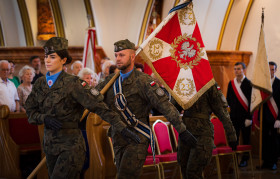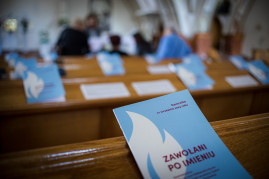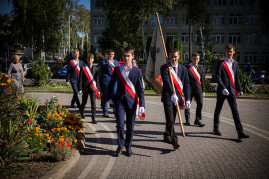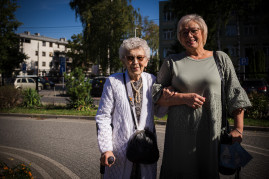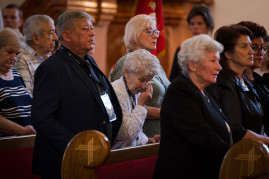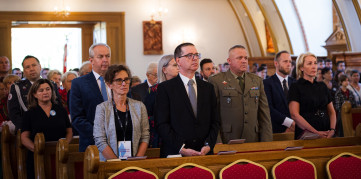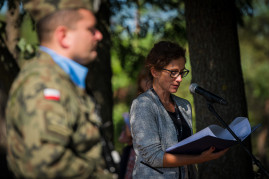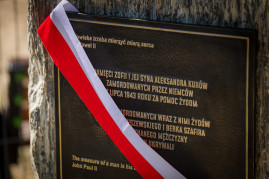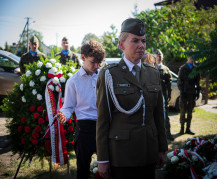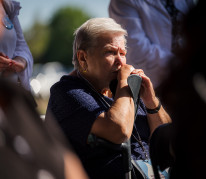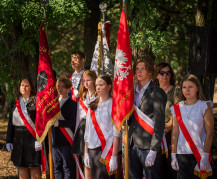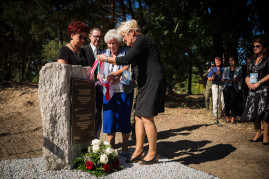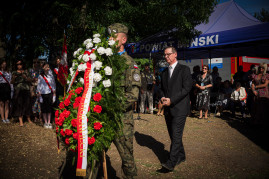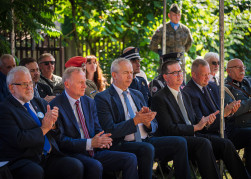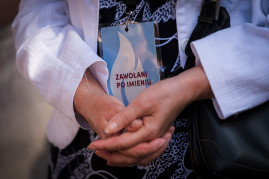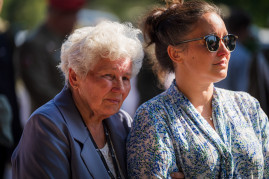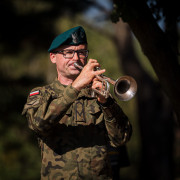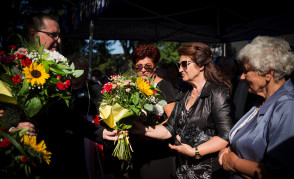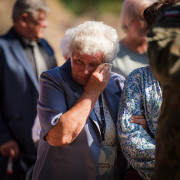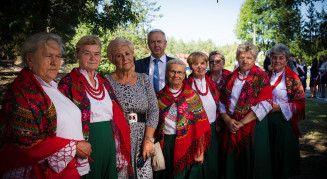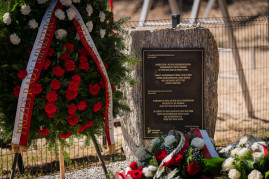The commemoration of Zofia and Aleksander Kur - Instytut Pileckiego
The commemoration of Zofia and Aleksander Kur
On 21 September 2023, in Gamratka near Mińsk Mazowiecki, as part of the “Called by Name” program, the Pilecki Institute commemorated Zofia and Aleksander Kur, who were murdered on 27 July 1943 by German gendarmes for helping three Jewish escapees from the ghetto in Mińsk.
The total of 89 victims have been commemorated during 34 events organized as part of the “Called by Name” program devoted to those who lost their lives for aiding Jews designated for extermination during the German occupation.
The event in Gamratka was organized in close cooperation with members of the local government: Antoni Jan Tarczyński – the Mińsk Starost, Marcin Jakubowski – Mayor of Mińsk Mazowiecki, Antoni Janusz Piechoski – Head of the Mińsk Mazowiecki Commune, and Leszek Celej – Director of the Museum of the Mińsk Mazowiecki Region.
The ceremony began with Holy Mass at the Saint John the Baptist Church in Mińsk Mazowiecki. Afterwards, a stone commemorating the victims was unveiled in front of the playground in Gamratka.
“The words of Zbigniew Herbert have become the motto of the Institute, which aims to commemorate all those who were murdered for helping Jews during World War II,” said Professor of the Pilecki Institute Andrzej Zawistowski from the Center for Totalitarian Studies, emphasizing the intention to commemorate the victims where they lived, lent aid to Jews and died. “That is where their memory should last and bear fruit […]. The three escapees hid in a dugout at Zofia Kur’s farmstead at night and in the nearby forest during the day. We must remember that the Kurs chose to save these people from death. It was an important choice – how to help them. Zofia Kur was alone with her four children. Her husband had been deported to Germany for forced labor” – he stressed. “When we think about what happened here, we see the history of totalitarianism as through a lens. This history had been written hundreds of kilometers away, through digits, numbers and dehumanized language. It is unjust that we know the names of the people who wrote this atrocious script, but we do not know the identities of those who lived here and fell victim to this totalitarian regime” – he emphasized.
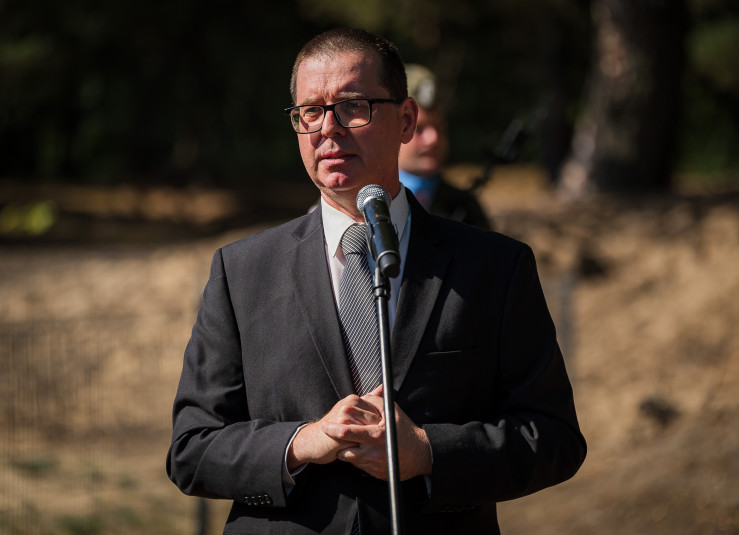
Present during the ceremony were the granddaughters of Zofia Kur: Janina Piekarska, Apolonia Pleban, Ewa Mauer and Barbara Przedlacka.
“When our grandfather Stanisław came back from forced labor in Germany to the burnt down house in Gamratka, his wife and children were gone. Our mother told us this tragic story” – said the granddaughter of the murdered Zofia Kur, Janina Piekarska, during the unveiling of the commemorative stone.
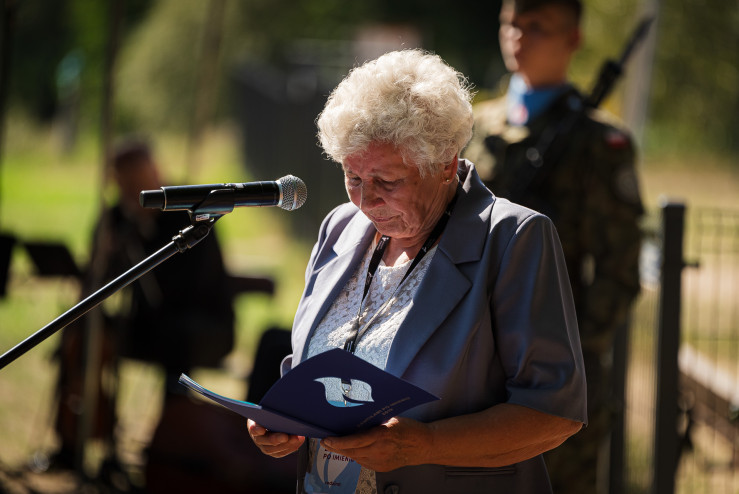
Source: Polish Press Agency
The commemorative stone was unveiled by Prof. Andrzej Zawistowski and the representatives of the Kur family, and then blessed by the parish priest, Fr. Marian Sobieszko. The attendees honored Zofia and Aleksander Kur, as well as the Jews whom they were hiding, with a minute of silence, keeping in mind all victims of World War II and the Holocaust.
Active during the ceremony were also soldiers of the 23rd Tactical Air Base, employees of the Museum of the Mińsk Mazowiecki Region and the Museum of the 7th Regiment of the Lublin Uhlans, as well as students of the Henryk Sienkiewicz Elementary School No. 6 in Mińsk Mazowiecki.
The story of Zofia Kur and her son Aleksander
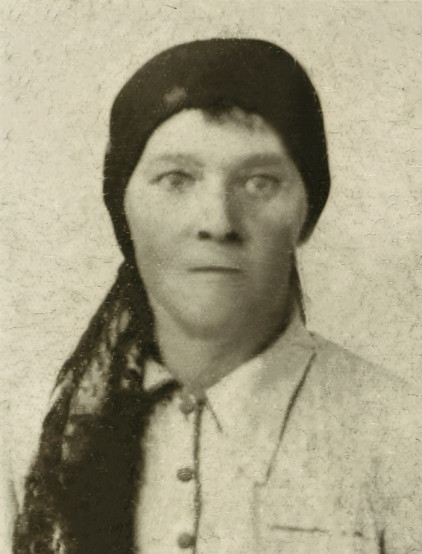
The German invasion of 1939 brought about many years of a brutal occupation. The pervasive repression and terror gradually destroyed the Polish society. The most severe persecution was inflicted upon the Jewish population. In October 1940, the Germans set up a ghetto in Mińsk Mazowiecki, forcing over 5,000 Jews to settle there. Less than two years later, in August 1942, they began the liquidation of the ghetto and sent most of its inhabitants to the extermination camp in Treblinka. On top of that, they shot about a thousand people during the liquidation process. Those who managed to avoid execution or deportation began a dramatic struggle for survival. In June 1943, three Jews came to Zofia Kur’s farmstead, seeking shelter. The men who had escaped from one of the labor camps located in Mińsk Mazowiecki were Lejzor Matuszewski, Berek Szafir and another man whose name remains unknown. Zofia Kur decided to give them shelter, despite the fact that helping Jews was punishable by death. The woman lived with her children: Jan (aged 21), Aleksander (aged 18), Stefan (aged 12) and Krystyna (aged 7) in the village of Gamratka near Mińsk Mazowiecki. The Kur family earned their living by working on their farm. Their financial situation was very difficult, because Stanisław Kur, Zofia’s husband, had been deported to the Third Reich for forced labor. The Jews hid in a dugout next to the house. During the day, they hid mostly in the forest, and came to the farmstead at night. When food became scarce, Berek Szafir decided to write to his prewar acquaintance, Jan Kamiński, asking for some of the money that the Jews had left with Kamiński for safekeeping. It is worth noting that Kamiński had also taken over the slaughterhouse owned by Berek’s father, Mechel Szafir. Zofia Kur was the one who delivered the letter. Having read its content, Kamiński wrote down the address of the hideout used by the Jews. He promised to personally bring the money on the following day. Unfortunately, who arrived in Zofia Kur’s farmstead on the morning of 27 July 1943 instead of the promised help was the German gendarmerie and the blue police. The operation was headed by the infamously cruel deputy commandant of the gendarmerie in Mińsk Mazowiecki, Friedrich Gutberlet. He was responsible for the deaths of, among others, Kazimierz Przekora and three unidentified Jews murdered in Huta Mińska. Gutberlet ordered several local farmers to go to the Kur farmstead. According to witnesses, the Germans surrounded the house and knocked on the window. Inside the house was Zofia and her son Aleksander. The rest of the children were staying at their relatives’ place in the village of Karolina. When the woman came out of the house, she was asked if she was hiding someone. Zofia denied. The gendarmes began the search. A potato cellar in the yard caught their attention. The Germans started tossing grenades into the cellar. Screams of the people inside could be heard amidst the explosions. Gutberlet ordered that tree branches covering up the entrance to the hideout be removed and the hiding persons be pulled outside. Two of them were severely injured, one was most likely already dead. The Jews were searched and subjected to an interrogation. The men did not turn their helpers in, and instead they claimed that they had only spent there one night, without Zofia’s knowledge. After the interrogation ended, Gutberlet personally shot the Jews. The gendarmes ordered Aleksander Kur and Stanisław Frelak – another Pole who was present at the scene – to deepen the partly filled-in dugout. When the Germans decided that the pit was deep enough, Frelak was allowed to climb out, while Aleksander was shot with a pistol. The Jews who had been murdered earlier were thrown into the same pit. Gutberlet forced Zofia to enter the house with him. He told her to stoop to pick up some items from under the bed. When she did, Gutberlet shot her dead. The Germans then proceeded to rob the farmstead. Having taken the most valuable items, they set the house on fire. Afterwards, they threatened the farmers present on the scene that if they learned that other Jews were hiding in the village, the inhabitants would be shot and their houses would be burned down, just like in the case of the Kur family. The bodies of the murdered Jews were buried at the execution site. Zofia and Aleksander Kur were interred at the cemetery in Mińsk Mazowiecki.
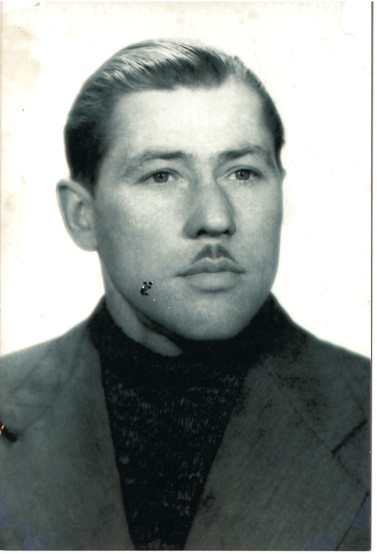
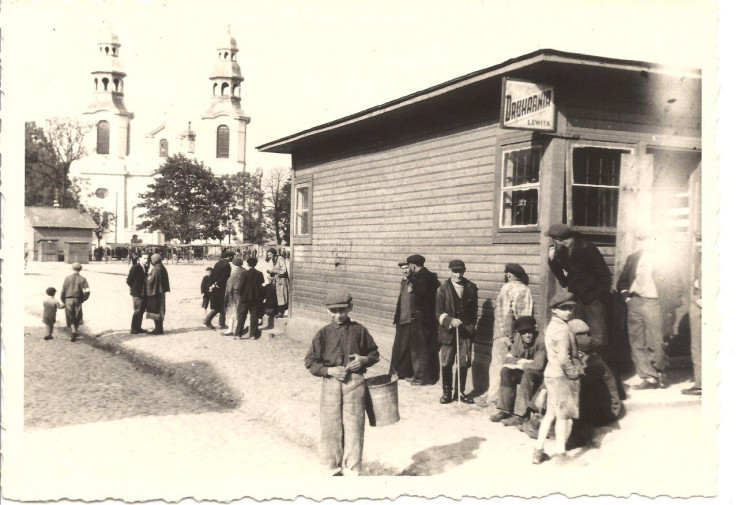
Witness accounts
Zofia Kur was told to enter the house. A gendarme followed her inside and shot her dead. The same gendarme took the most valuable items from the house, tossed a grenade into the building and shot at the thatched roof, setting the house on fire. Aleksander Kur and Stanisław Frelak dug a pit. Afterwards, Frelak was told to climb out, while Aleksander Kur was killed in the pit. The three Jews were thrown into the same pit and buried.
Testimony of witness Kazimierz Gniada from 15 April 1948, APW, SOW, 3165, p. 15.
[…] at about 3 a.m. I heard grenade explosions and moments later two Germans and one blue policeman came to my house. They led me and several other people to Zofia Kur’s house. There, two Jews were already dead and one was wounded. I saw Aleksander Kur and Stanisław Frelak dig a pit. Frelak was then told to climb out, while Aleksander Kur was killed in the pit. I was told to throw the Jews who had been killed in the dugout into the pit and bury them. Zofia Kur was killed in the house. One gendarme and the policemen took the most valuable items from the house. The gendarme fired his machine gun at the thatched roof, setting the house on fire. A gendarme said that those who were hiding Jews would share the same fate, and he showed us a letter which served as evidence. I heard the blue policemen say that Zofia Kur had brought this letter to someone in order to ask for money, but I didn’t hear who it was. After the pit was buried and the house was burned down, I was allowed to go home.
Testimony of witness Jan Dębicki from 15 April 1948, APW, SOW, 3165, pp. 16–17.
I don’t remember the date, it happened in June 1943, at about 2 a.m. While sleeping in the barn, I was woken up by the sound of grenades. I went out to see what happened. A German gendarme who was standing in the yard noticed me and called me over. The gendarmes gathered several people from the village and told them to walk to the Kur farmstead. The gendarmes pointed to the hideout and told me to look for the Jews. I began to uncover the hideout and found the three Jews who had been injured by German grenades. We were told to come out and search the Jews. Afterwards, we had to deepen the pit. The task was performed by Aleksander Kur and Stanisław Frelak. We were then told to climb out, while Kur was told to keep digging. Moments later, a gendarme shot him in the back of the head. Zofia Kur was killed in the house. The building was set on fire. I did not see the letter that the gendarme had in his possession, but I had heard Zofia Kur plead with the gendarmes before she was killed. One of the gendarmes read her letter and said that it was evidence that she had been hiding Jews. That’s all I know about this matter.
Testimony of witness Józef Książek from 17 April 1948, APW, SOW, 3165, pp. 20–21.

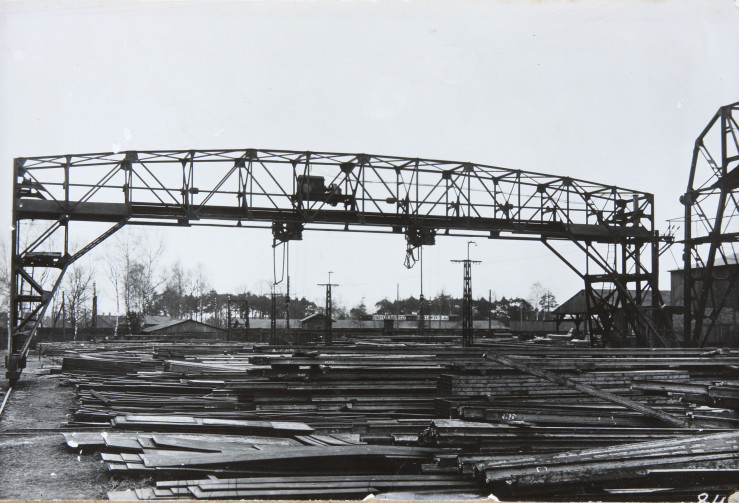
The grounds of the Rudzki factory in the 1920s and 1930s. During World War II, it was the site of a labor camp which belonged to the Krupp company. The Jews who hid at Zofia Kur’s farm had most likely escaped from there. Photograph from the collection of the Society of Friends of Mińsk Mazowiecki.
As part of the “Called by Name” program, the Pilecki Institute is recovering the stories of Poles who paid for saving Jews from the Holocaust with their own lives and the lives of their loved ones. The program combines research, historical education and various other activities concerning the culture of remembrance. Archival research, which serves to accurately retrace the events in question, is accompanied by visits to the scenes of the crime – most often in small towns and villages – interviews with witnesses and filmed recordings of testimonies. Of paramount importance is the establishment of a relationship with the families of the victims and the descendants of the rescued Jews, if these latter managed to survive. In each case, the highlight is the unveiling of a stone with an inscription that commemorates the murdered Poles and the rescued Jews who died with them in both Polish and English. It becomes a permanent sign of remembrance of the heroes in the public space where tragic events took place. Integrating the milieu of the “Called by Name” families helps them to cope with the difficult experiences of their past. Thanks to meetings and educational workshops for young people, local communities can learn and understand their own history. A broad information campaign serves to introduce the fate of the “Called by Name” to the collective memory in Poland and around the world.
The “Called by Name” project aims to do justice to the heroic acts of Poles who consciously risked their own lives and the lives of their loved ones to help Jewish friends, neighbors, and sometimes strangers, and paid the highest price. At the same time, the project highlights the realities of the ruthless German occupation policy in Poland, which destroyed all ties of solidarity between Poles and Jews, and punished the slightest human gesture of compassion with death. The “Called by Name” also convey a universal message of courage, sacrifice and solidarity with the persecuted, which set the measure of the radical evil of totalitarianism and genocide.
